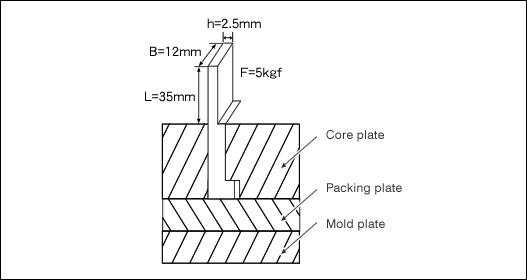#011 Bending of Core Pins due to Injection Pressure
The basic equations for calculating the bending deformation of core pins due to the injection pressure are explained here.
In injection molding, since a high filling pressure acts inside the cavity, thin and long mold parts such as core pins can get deformed or may even cause breakage accidents. The pressure acting on a core pin is different in different cases depending on the flow pattern of the molten plastic, the gate placement, etc., and hence actual calculations of the accurate strength are quite complex. Therefore, usually, the state of action of the pressure is approximated (simplified) and only basic calculations are made. The basic method of calculating the deformation (bending) of a core pin is explained below.
The maximum amount of deflection (δmax) in a cantilever beam structure is calculated using the following equations.
(1) When a concentrated load acts upon the tip of the core pin

Here, δmax is the maximum amount of bending (cm), W is the concentrated load (kgf), E is the longitudinal elastic modulus (kgf/cm2), and I is moment of inertia of area(cm4).
(2) When a uniformly distributed load is assumed to act on the side surface of the core pin

Where, W is the uniformly distributed load(kgf/cm2)
In actuality, in the periphery of the core pin, since the molten plastic flows around instantaneously, it is considered rare that the pressure acts simply in only one direction. In the case of a thin and long core pin, etc., since the pressure may act during the process of (1) or (2) depending on the gate position, it is possible to carry out the basic calculations by substituting the data in the above equations.




